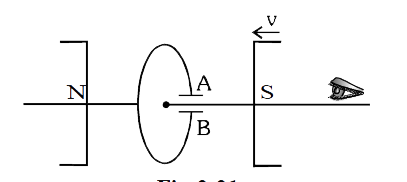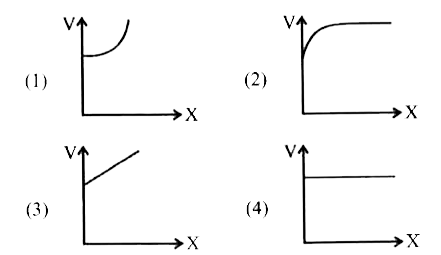Force on a charge between plates of capacitor is 10N. What will be force if one plate is removed.
To solve the problem of finding the force on a charge when one plate of a capacitor is removed, we can follow these steps:
Step 1: Understand the Initial Conditions
We have a parallel plate capacitor with two plates, one positively charged and the other negatively charged. The force on a charge q placed between these plates is given as F=10N.
Step 2: Determine the Electric Field Between the Plates
The electric field E between two plates of a parallel plate capacitor is given by:
E=σϵ0
where σ is the surface charge density on the plates and ϵ0 is the permittivity of free space.
Step 3: Calculate the Force on the Charge
The force F on the charge q in the electric field E is given by:
F=qE
Since we know F=10N, we can express this as:
10=q⋅σϵ0
Step 4: Analyze the Situation When One Plate is Removed
When one plate is removed (let's say the negatively charged plate), the charge q will now only experience the electric field from the remaining positively charged plate. The electric field due to a single plate is:
E′=σ2ϵ0
Step 5: Calculate the New Force
Now, the new force F′ on the charge q in the electric field E′ is:
F′=qE′=q⋅σ2ϵ0
Substituting E′ into the equation:
F′=12⋅q⋅σϵ0
From the previous step, we know q⋅σϵ0=10N. Therefore:
F′=12⋅10=5N
Conclusion
The force on the charge when one plate is removed is F′=5N.
---
We have a parallel plate capacitor with two plates, one positively charged and the other negatively charged. The force on a charge q placed between these plates is given as F=10N.
The electric field E between two plates of a parallel plate capacitor is given by:
E=σϵ0
where σ is the surface charge density on the plates and ϵ0 is the permittivity of free space.
The force F on the charge q in the electric field E is given by:
F=qE
Since we know F=10N, we can express this as:
10=q⋅σϵ0
When one plate is removed (let's say the negatively charged plate), the charge q will now only experience the electric field from the remaining positively charged plate. The electric field due to a single plate is:
E′=σ2ϵ0
Now, the new force F′ on the charge q in the electric field E′ is:
F′=qE′=q⋅σ2ϵ0
Substituting E′ into the equation:
F′=12⋅q⋅σϵ0
From the previous step, we know q⋅σϵ0=10N. Therefore:
F′=12⋅10=5N
The force on the charge when one plate is removed is F′=5N.
Topper's Solved these Questions
Similar Questions
A capacitor is given a charge q. The distance between the plates of the capacitor is d. One of the plates is fixed and the other plate is moved away from the other till the distance between them becomes 2d. Find the work done by the external force.
View SolutionWhat is an equipotential surface ? Write three properties Sketch equipotential surfaces of
(i) Isolated point charge
(ii) Uniform electric field
(iii) Dipole If charge Q is given to a parallel plate capacitor and E is the electric field between the plates of the capacitor the force on each plate is 1/2 QE and if charge Q is placed between the plates experiences a force equal to QE. Give reason to explain the above.
View Solution
Knowledge Check
The potentials of the two plates of capacitor are +10V and −10V. The charge on one of the plate is 40C. The capacitance of the capacitor is
A2FB4FC0.5FD0.25FForce of attraction between the plates of a parallel plate capacitor is
Aq22ε0AKBq2ε0AKCq2ε0ADq22ε0A2KThe separation between the plates of a charged parallel-plate capacitor is increased. The force between the plates
AincreasesBdecreasesCremains sameDfirst increases then decreases
What is the nature of the charge on the plates of capacitor ?

View SolutionA parallel plate capcitor of capacitance C is charged to a potential V by a battery. Without disconencting the battery = distance between the plates of capacitor is triple and a dielectric medium of K = 10 is introduced between the plates of capacitor. Explain giving reasons how will the following be affected ?
(a) Capacitance of capacitor
(b) Charge on capacitor
(c ) Energy density of capacitor.
View Solutionseparation between the plates of a parallel-plate capacitor is 2 mm and the area of its plates is 5cm2. If the capacitor is charged such that it has 0.01J energy stored in it, the electrostatic force of attraction between its plates is _______N.
View SolutionBetween the plates of a parallel plate capacitor a dielectric plate in introduced just to fill the complete space between the plates. The capacitor is charged and later disconnected from the battery. The dielectric plate is then slowly drawn out of the capacitor plates. the plot of the potential difference across the plates and the length of the dielectric plate drawn out is

View SolutionA battery is used to charge a parallel plate capacitor till the potential differece between the plates becomes equal to the electromotive force of the battery. The ratio of the energy stored in the capacitor and the work done by the battery will be
View Solution
